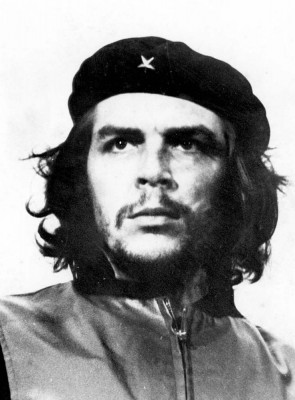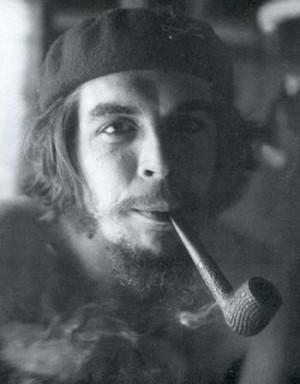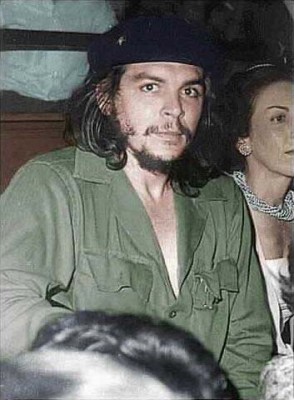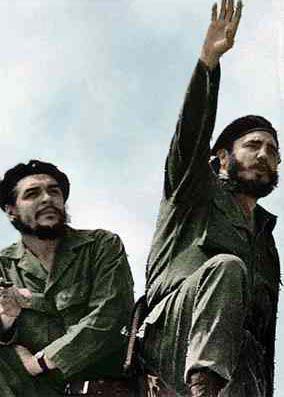| Che Guevara | |
|---|---|
 |
|
| Cuban Revolutionary | |
| Born | 1928 Rosario, Argentina |
| Died | 1967 La Higuera Vallegrande, Bolivia |
| Nationality | Argentinian |
Che Guevara was a Marxist revolutionary and military leader from Argentina. Fully named Ernesto Guevara de la Serna, but commonly known as Che, he was a key figure in the Cuban revolution of 1959. He served there in government for a while, but then left to attempt to provoke revolution elsewhere in Latin America and Africa. He was eventually caught and executed by government forces in Bolivia. His image has become a symbol of the counter-culture around the world.
Early Life
Despite his later fame as a revolutionary, Guevara’s childhood was a comfortable one. Born in the city of Rosario in central Argentina, he enjoyed the benefits of a good education. The family’s frequent moves during Guevara’s childhood, however, may have played a part in his development of severe asthma. The attacks that he endured were of great severity, so much so that those witnessing the events were sometimes concerned for his life. Despite this handicap, Guevara refused to let his asthma beat him. He was active in a number of sports, particularly swimming and rugby.
In his late teens, Guevara went to look after his grandmother in Buenos Aires. She was elderly, and did not survive long. Guevara later enrolled in medical school. A decision that may have been prompted by his frustration at being powerless to keep his grandmother alive.
South America by Motorcycle
In late 1951, Guevara, joined by Alberto Granado, a close friend of his, set off on a trip by motorcycle across South America. Eventually, the motorcycle itself broke down and was left in Santiago, but the journey itself continued on by other means. The pair visited Chile and Peru, then moved on to Colombia and Venezuela. At this point, Granado returned home, but Guevara traveled onward to Miami before going home. He had made copious notes of what he had seen and experienced during his travels. Eventually these notes were made into a book and, much later, a film called The Motorcycle Diaries.
During his South American trip, Guevara was deeply affected by the amount of poverty he witnessed all over the continent. He decided that he would make it his mission to do something about it. Once he had completed his studies in medical school, he set off on another journey, this time traveling through the Andes to Central America via Ecuador and Colombia. He lived for a time in Guatemala, whose president was implementing radical land reforms. The government was ousted in a CIA-backed coup a little later. Guevara, who by now had become known as Che, attempted to help the resistance. However, the fighting was over before he could take up arms.
Mexico and Cuba
Guevara traveled to Mexico and became a close friend of Raúl Castro, who had been closely involved in the 1953 rebellion in Cuba. Raúl’s brother Fidel led a movement with the aim of deposing Fulgencio Batista, the United States-backed dictator. Guevara found immediate common cause with Fidel Castro because of his fight against the U.S., a country whose imperialism Guevara detested. Guevara’s medical knowledge was seen as being highly valuable to the Cuban revolutionary cause.
Guevara also befriended another revolutionary, Camilo Cienfuegos. The two of them, along with 80 men, sailed the yacht Granma to Cuba at the end of November, 1956. The boat was extremely overloaded and barely reached the shore. After landing, Guevara’s band headed toward the mountains, but security forces detected and attacked them. Less than a quarter of the soldiers escaped to the mountains, including Guevara, Cienfuegos, and both Castro brothers. Guevara sustained some wounds. Once established in the mountains, the small band prepared for an extended guerilla campaign.
The Cuban Revolution
Guevara proved himself a highly significant figure during the revolution in Cuba. His intelligence, determination, dedication, and toughness made him extremely valuable to the cause, and he was quickly promoted through the revolutionary ranks. Once in command of a unit, Guevara impressed on them the importance of communism and insisted on dedication and discipline from his soldiers. The men frequently engaged in fighting with the Cuban army. In between these clashes, several journalists from overseas were permitted to visit Guevara in order to write stories which he felt might bring the revolution’s causes to a wider audience.
By 1958, Batista had decided that it was time to crush the revolution for good. That summer he ordered a large force into the mountains with the aim of destroying the rebels and their base completely. This proved to be a disastrous military error as the rebels, having hidden out in the mountains for two years, knew the terrain far better than the army and were easily able to defeat them. Many of Batista’s troops became so demoralized that they joined the revolutionaries or simply deserted. By the end of the year, Fidel Castro decided that it was time to launch a full revolt. He dispatched Guevara’s group and two others out into settled Cuba.
The Battle for Santa Clara
 Guevara’s unit was given the objective of capturing Santa Clara, a highly important city. It was defended by more than two thousand government troops, backed by strong defenses and even tanks. Guevara’s band numbered barely three hundred and had far lesser resources to call upon. Nevertheless, the rebels were buoyed by the support of the majority of Santa Clara’s ordinary inhabitants. Meanwhile the federal army was suffering from low morale brought on by the long, grinding war.
Guevara’s unit was given the objective of capturing Santa Clara, a highly important city. It was defended by more than two thousand government troops, backed by strong defenses and even tanks. Guevara’s band numbered barely three hundred and had far lesser resources to call upon. Nevertheless, the rebels were buoyed by the support of the majority of Santa Clara’s ordinary inhabitants. Meanwhile the federal army was suffering from low morale brought on by the long, grinding war.
On December 28, 1958, Guevara’s men arrived in the city and fighting began at immediately. After three days of the battle, the police headquarters building was taken by the rebels, but the barracks themselves were still occupied by the Cuban army. These soldiers, however, declined to make themselves available for battle, or even to leave the barracks, allowing Guevara an effective free hand. Batista, on hearing the news that he had lost what was to prove the revolution’s biggest battle, decided to give the order to pull out.
A New Cuban Government
The rebels, including Guevara, made a triumphal entry into Havana and set out on the long, hard road of creating a replacement government. Guevara himself was paired up with Raúl Castro and tasked with rounding up officials from the Batista regime. He was instrumental in organizing several hundred trials for these officials, of which the majority resulted in a guilty verdict, and the men in question being executed. This brought strong condemnation from the global community; however, Guevara’s unwavering belief in the rightness of the communist revolution left him unmoved. He was convinced that the men he called tyrants had to be made an example of.
Fidel Castro, who trusted few people, relied heavily on Guevara, who was given a number of tasks including running the Cuban Bank and heading up the Ministry of Industry. Even so, he found this work rather uninteresting, and he frequently traveled overseas in order to try to give Cuba a better reputation in the outside world. Back in Cuba, Guevara worked to create a communist economy in the country and pushed hard for better relations with the Soviet Union. One result of this push was the decision to allow the Soviets to station missiles in Cuba, which eventually led to the Cuban Missile Crisis in which the world briefly teetered on the brink of nuclear war.
Becoming weary of government
 By 1965, Guevara had realized that government work, even at an influential level, was not right for him. He was a natural revolutionary, and this would be his life’s vocation. He suddenly dropped out of the public life of Cuba, leading rumors that he had argued with Fidel Castro, and traveled to Africa. Guevara felt that the African continent was where western capitalism was at its weakest, and that communism could find a ready audience. He traveled to Congo, in order to lend support to Laurent Désiré Kabila’s own revolutionary struggle.
By 1965, Guevara had realized that government work, even at an influential level, was not right for him. He was a natural revolutionary, and this would be his life’s vocation. He suddenly dropped out of the public life of Cuba, leading rumors that he had argued with Fidel Castro, and traveled to Africa. Guevara felt that the African continent was where western capitalism was at its weakest, and that communism could find a ready audience. He traveled to Congo, in order to lend support to Laurent Désiré Kabila’s own revolutionary struggle.
Meanwhile, back in Cuba, Fidel Castro announced to his nation that “Che” had made a vow to fight imperialism and spread rebellion wherever he could. Despite these fighting words, however, Guevara’s African adventure ended in complete failure, largely because Kabila proved himself to be an unreliable ally. A large force of mercenaries from South Africa, led by Mike Hoare, was dispatched to destroy the rebels. Guevara could not prevail. He hoped to stay in Congo and die a martyr’s death, but he was eventually persuaded by his Cuban comrades to escape. He had spent nine months in the country, but had achieved almost nothing.
Failure in Bolivia
Guevara was still unprepared to remain in Cuba, and suggested trying to provoke a communist revolution in Argentina. He was, with some difficulty, persuaded that he would have a better chance of success in Bolivia. He traveled there in 1966. Unfortunately for him, this was as much of a debacle as his trip to Congo. His group of about 50 Cubans found that the underground group in Bolivia that was supposed to give them support was deeply unreliable. A more serious problem was the CIA, which was actively involved in training Bolivian officers in how to fight insurgencies. Before long, the CIA were well aware of Guevara’s activities.
In the middle of 1967, Guevara’s soldiers managed some small victories in skirmishes with Bolivian troops. However, that August, they were attacked and their numbers were reduced by a third in the ensuing shoot-out. By the time the fall began to close in, the 20 or so men who remained were running out of essential supplies and even food. The government in Bolivia had offered a reward of four thousand dollars for information on Guevara’s whereabouts, and this substantial sum of money may have led to his betrayal by elements of the communist underground. By early October, army soldiers were well on his trail.
Death and Legacy
On October 7, Guevara made the decision to halt his men in the Yuro ravine to recuperate. Peasants living in the area informed the Bolivian army, who quickly attacked. The ensuing firefight saw Guevara sustain a wound to his leg and several other rebels were killed. He escaped, but only for one more day when he was taken alive. Guevara was quickly taken for interrogation by the security forces, including officers from the CIA, but they discovered little of importance. The communist revolutionary cause in Bolivia had essentially failed with him. On October 9, he was executed by shooting.
With his violent death, Guevara came to be seen as a revolutionary martyr, the very status he had wanted for himself for so long. He remains a hero to many people around the world for his anti-imperialist beliefs and support for working people. In Cuba he is considered one of the outstanding national figures. However, an alternative view of Guevara is of him as a murderer, because of his enthusiastic support for the execution of Batista’s men. They also point out that he was not a notable success at economic management in Cuba, and that he represented an ideology which has been conclusively defeated in the modern world. Even in death, Che Guevara remains a highly controversial figure.

